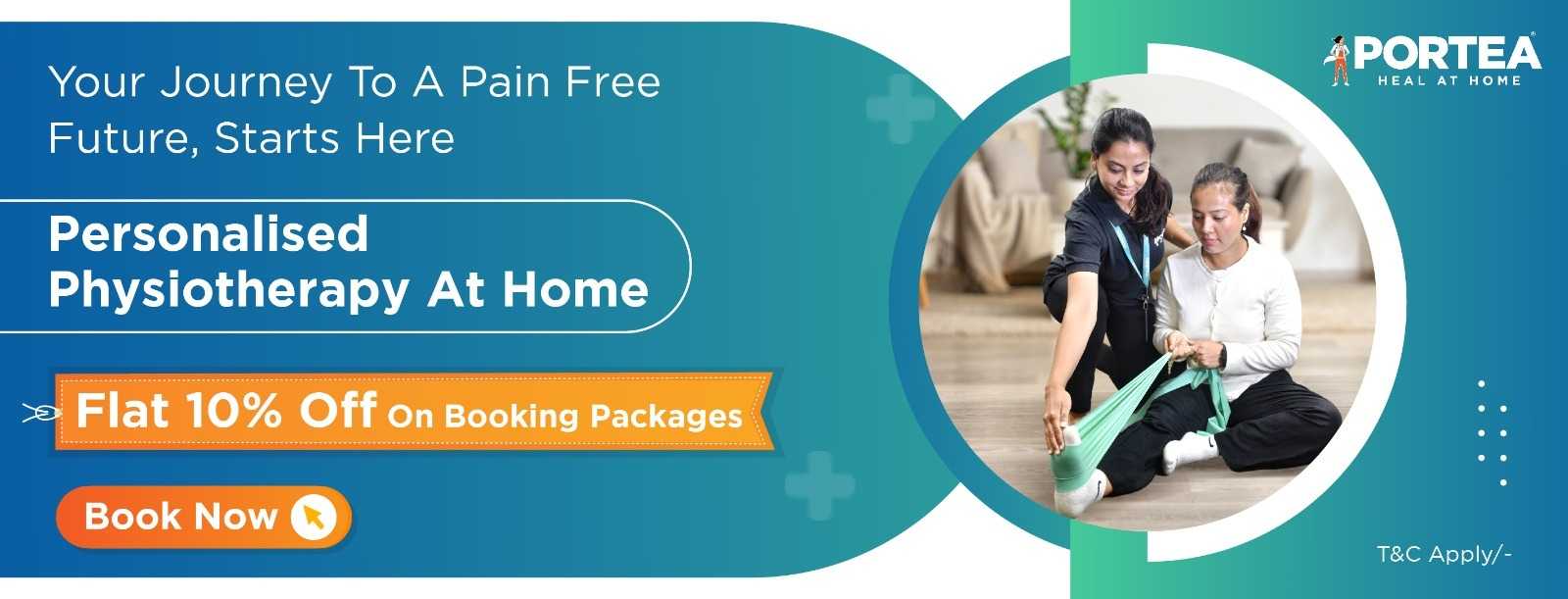
Expert Physiotherapy at Home
Certified physiotherapists visit you at home to provide focused, one-on-one care tailored to your needs. With no travel or waiting rooms, recovery happens in a setting that is comfortable, familiar, and built around your convenience.
Personalised Recovery Programmes
Every treatment plan is designed to suit your condition, goals, and pace. Our physiotherapists follow structured, evolving protocols to ensure consistent progress, with each session aligned to deliver meaningful results.
Trusted Physiotherapists. Real Results.
Our team comprises experienced, background-verified physiotherapists trusted by thousands of families. With a strong focus on safety, reliability, and clinical outcomes, we make recovery at home both effective and reassuring
Patient Testimonials
Portea Physiotherapists for Home Visits
Meet some of our experienced and dedicated healthcare professionals

Dr. Lokesh G
Physiotherapist
Specializations
Experienced in Neurological rehabilitation, Orthopaedic physiotherapy, and Paediatric care
Delivers structured, high-impact treatment plans across neuro, ortho, and paediatrics—ensuring safety, comfort, and measurable recovery at every stage.

Dr. Mohammed Sarwar
Physiotherapist
Specializations
Experienced in Neurological rehabilitation, Adult physiotherapy, and Paediatric care
Combines deep clinical expertise with a compassionate approach, supporting both adults and children through neuro and physical rehabilitation that promotes long-term independence and recovery.

Dr. Nelapati Divya
Physiotherapist
Specializations
Skilled in Orthopaedic rehabilitation, Manual therapy techniques, and Paediatric physiotherapy
Brings a personalised, hands-on approach to healing—combining structural expertise with paediatric sensitivity to restore movement, relieve pain, and improve everyday function.

Dr. Naveen V
Physiotherapist
Specializations
Trained in Pain management, Cardiac and Orthopaedic rehabilitation, Neurological care, and Neural tissue mobilisation
Brings clinical precision and empathy together—designing science-backed recovery protocols for pain relief, nerve mobilisation, and cardio-neuro-ortho rehabilitation across all age groups

Dr. Miloni Savla
Physiotherapist
Specializations
Holds an MPT in Orthopaedics with a focus on Musculoskeletal rehabilitation and strength recovery
Delivers focused, movement-oriented therapy grounded in orthopaedic science—helping patients rebuild strength, restore function, and return to daily life with confidence
Other Cities
Physiotherapy Treatments

supraspinatus tendinosis vs. tendinopathy: what’s the difference?
Although the terms supraspinatus tendinitis and supraspinatus tendinopathy are sometimes used interchangeably, they’re not quite the same.
- Tendinitis refers to active inflammation in the tendon, typically caused by overuse or sudden injury. It usually responds well to rest and anti-inflammatory treatments.
- Tendinopathy is a broader term that includes chronic tendon injuries where the tendon may be degenerating without much inflammation. Treatment tends to focus more on rebuilding tendon strength and improving function over time.
symptoms of supraspinatus tendinosis
In the early stages, symptoms might be mild or only noticeable during specific activities. As the condition progresses, people often experience:
- Shoulder pain, especially at the top or front of the shoulder, sometimes radiating down the upper arm
- Painful arc, or pain during a specific part of arm movement—typically between 80° to 120° of sideways lifting
- Weakness in the arm or shoulder, particularly when lifting or reaching overhead
- Limited function, especially with activities above shoulder height
- Nighttime discomfort, especially when lying on the affected side
- Normal passive movement, meaning the shoulder can be moved through its full range with assistance, but active movement may be painful or limited
causes of supraspinatus tendinosis
Several factors can contribute to supraspinatus tendinosis:
- Repetitive overhead movements, like those in sports (tennis, swimming) or certain jobs (painting, construction)
- Heavy lifting, especially above shoulder height
- Poor posture, which can reduce the space where the tendon moves, increasing the chance of irritation
- Aging, as natural wear and tear narrows the subacromial space
- Injuries, such as a fall on an outstretched arm
- Structural issues, like bone spurs or abnormal shoulder anatomy that cause impingement
- Shoulder instability, where weak muscles allow too much movement in the joint, stressing the tendon
treatment options for supraspinatus tendinosis
Treatment typically starts with simple self-care, including:
- RICE method: Rest, ice, compression, and elevation
- Over-the-counter medications, such as NSAIDs, to reduce inflammation and pain
- Corticosteroid injections, if oral medications don’t provide enough relief
If symptoms persist, physiotherapy plays a key role in recovery. A physiotherapist can design a personalized program to reduce pain, restore movement, and build strength in the rotator cuff muscles. In more serious cases, especially where there’s a tear or long-standing tendon damage, surgery may be considered as a last resort.
why physiotherapy matters in supraspinatus tendinosis recovery
Physiotherapy is one of the most effective ways to treat supraspinatus tendinosis. It helps by:
- Reducing pain through manual therapy, ice, ultrasound, or electrical stimulation
- Improving mobility with gentle stretches and movement exercises
- Building strength in the shoulder muscles to support the tendon and prevent re-injury
- Correcting posture and teaching better movement habits
- Customizing care based on your lifestyle, severity of symptoms, and recovery goals
who’s at risk for supraspinatus tendinosis?
You’re more likely to develop supraspinatus tendinosis if you:
- Perform frequent overhead activities in sports or work
- Have poor posture or shoulder mechanics
- Are over 40, as age-related wear increases risk
- Have had a previous shoulder injury
- Live with conditions like diabetes
- Experience shoulder impingement due to bone spurs or instability
portea also offers
In addition to specialized sports hernia care, Portea provides a wide range of physiotherapy services to support various recovery needs:
- In-home physiotherapy for personalized, one-on-one treatment plans tailored to specific conditions and recovery goals.
- Online physiotherapy sessions for flexible, remote care guided by certified experts—ideal for those with busy schedules or limited mobility.
- Support for chronic pain, post-surgery rehabilitation, mobility enhancement, and strength training.
why choose portea?
Portea combines clinical expertise with convenience, offering care that fits into your lifestyle. Whether you need advanced physiotherapy, expert consultation, or real-time monitoring, our team ensures compassionate, goal-oriented support—all from the comfort of your home. With a focus on recovery, prevention, and long-term wellness, Portea stands as your trusted partner in health.
faqs
1. How is supraspinatus tendinitis diagnosed?
Doctors typically begin with a physical exam and medical history, followed by imaging tests like an ultrasound or MRI to check for inflammation, tears, or narrowing in the shoulder space.
2. Can a supraspinatus tendon tear be prevented?
While you can’t eliminate all risk, strengthening your shoulder muscles, maintaining good posture, and using proper technique during sports or physical activity can greatly reduce your chances of injury.
3. How is a supraspinatus tendon tear treated?
Treatment usually starts with rest, ice, NSAIDs, and physical therapy. If these don’t help, corticosteroid injections or surgery might be necessary depending on the severity of the tear.
4. Is surgery always needed for supraspinatus tendinosis?
No. Most people recover with non-surgical treatments. Surgery is only recommended if pain persists or if there is significant structural damage.
5. Why is physical therapy so important for supraspinatus tendinosis?
It addresses the root causes—like weakness, poor posture, or movement habits—and helps restore full function without relying on long-term medication or invasive procedures.
References
Doctor Consultation
Nursing
Physiotherapy
Trained Attendant
Elder Care
Mother & Baby Care
Lab Tests
Medical Equipment
Speciality Pharma
Critical Care





